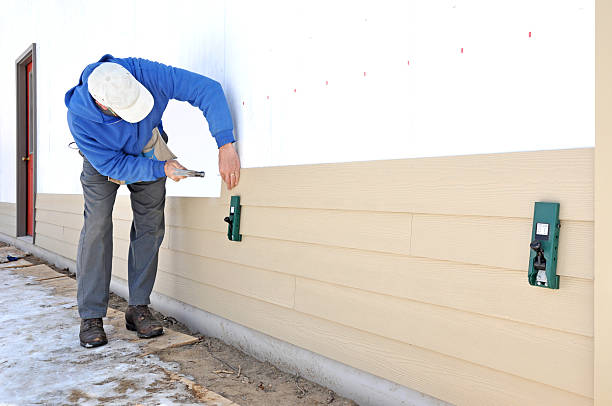Siding installation is a critical aspect of home improvement that can significantly enhance your property’s appearance and durability. Whether you’re building a new home or renovating an existing one, choosing the right siding in Fayetteville NC can make a world of difference. In this guide, we’ll explore the various types of siding, the benefits of installation, the process involved, and much more.
Understanding Siding: What Is It?
Siding refers to the exterior material applied to the walls of a house. It serves as a protective barrier against the elements while also contributing to the home’s overall aesthetic. There are various materials available for siding, including wood, vinyl, fiber cement, and metal, each with unique characteristics and advantages.
Benefits of Siding Installation
Enhanced Curb Appeal
New siding can dramatically improve your home’s exterior. With a variety of colors, styles, and materials available, homeowners can choose options that reflect their personal taste while increasing the property’s value.
Improved Energy Efficiency
Quality siding can help insulate your home, reducing energy costs. Insulated siding prevents heat loss during winter and keeps your home cool in the summer, contributing to lower utility bills.
Protection Against Weather Elements
Siding serves as the first line of defense against harsh weather conditions. It protects your home from rain, wind, snow, and extreme temperatures, thereby extending the life of your home’s structure.
Reduced Maintenance Requirements
Modern siding materials are designed to be durable and low-maintenance. For instance, vinyl siding does not require painting and can be easily cleaned with a hose, making it an attractive option for busy homeowners.
Choosing the Right Siding Material
Vinyl Siding
Vinyl siding is a popular choice due to its affordability, durability, and low maintenance. Available in a wide range of colors and styles, it’s resistant to moisture and insects, making it a practical option for many homeowners.
Wood Siding
Wood siding offers a classic and natural appearance. While it requires regular maintenance, such as painting or staining, it can provide excellent insulation and aesthetic appeal.
Fiber Cement Siding
Fiber cement is a highly durable material that mimics the appearance of wood but offers better protection against rot and pests. It’s available in various styles and can be painted to match your desired look.
Metal Siding
Metal siding, typically made of aluminum or steel, is known for its durability and resistance to fire. It’s also low maintenance and available in various finishes, making it a modern option for contemporary homes.
The Siding Installation Process
Assessment and Planning
Before installation begins, a professional contractor will assess your home’s exterior and discuss your goals and preferences. This step involves measuring the area to determine how much siding material will be needed.
Preparing the Surface
Proper preparation of the surface is essential for a successful installation. This may involve removing old siding, repairing any damage to the underlying structure, and ensuring a clean, dry surface.
Installation of Moisture Barrier
A moisture barrier is installed to protect your home from water damage. This layer helps prevent moisture from seeping behind the siding, which can lead to mold and structural issues.
Siding Application
The siding is then applied according to the manufacturer’s guidelines. This process varies based on the type of siding but generally involves fastening the panels securely to the exterior walls.
Finishing Touches
After the siding is installed, finishing touches are added, such as trim around windows and doors, to ensure a polished look. Finally, a thorough inspection is conducted to ensure everything is up to code.
DIY vs. Professional Installation
While some homeowners may consider a DIY approach to siding installation, hiring a professional is often recommended. Experienced contractors possess the skills and tools needed for a proper installation, ensuring the job is done efficiently and to a high standard. Additionally, professionals can offer warranties and insurance, providing peace of mind for homeowners.
Frequently Asked Questions (FAQs)
How long does siding installation take?
The duration of the installation process can vary depending on the size of the house and the type of siding being installed. Typically, a full installation can take anywhere from a few days to a couple of weeks.
What is the average cost of siding installation?
The cost of siding installation varies based on the material chosen, the size of your home, and labor costs in your area. On average, homeowners can expect to spend between $5,000 and $15,000 for siding installation.
How can I maintain my siding?
Maintenance requirements depend on the type of siding. For instance, vinyl siding usually requires minimal maintenance, while wood siding needs regular painting or staining to protect it from the elements. Always follow the manufacturer’s guidelines for care.
Will new siding increase my home’s value?
Yes, new siding can enhance your home’s curb appeal and increase its value. Many homebuyers appreciate the benefits of new siding, which can lead to a better return on investment.
Can I install siding over existing siding?
In some cases, it’s possible to install new siding over existing siding, but it depends on the condition and type of the existing material. Consulting with a professional contractor is the best way to determine the best course of action.
Conclusion
Siding installation is more than just an aesthetic upgrade; it’s an investment in your home’s protection and value. By choosing the right material and hiring a professional for installation, you can ensure that your home remains beautiful and well-protected for years to come. If you’re considering new siding, take the time to explore your options and consult with experts to make informed decisions that suit your home and lifestyle.
